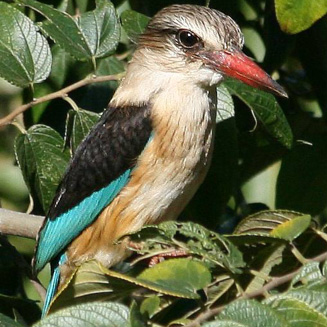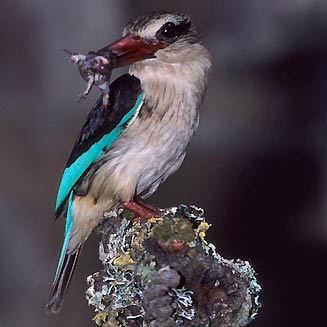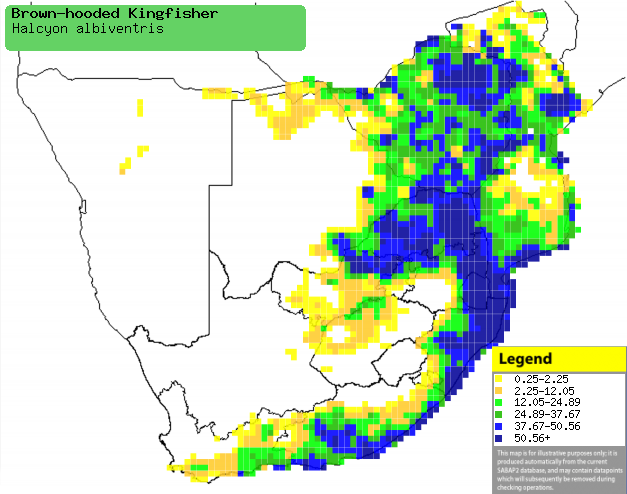|
Halcyon albiventris (Brown-hooded
kingfisher)
Bruinkopvisvanger [Afrikaans]; Undozela [Xhosa];
iNdwazela, uNongobotsha, uNongozolo [Zulu]; Muningi (generic term for
kingfisher) [Kwangali]; Sipholoti (also applied to Malachite kingfisher)
[Swazi]; Tshololwana (generic term for kingfisher) [Tsonga]; Bruinkapijsvogel
[Dutch]; Martin-chasseur à tête brune [French]; Braunkopfliest [German];
Pica-peixe-de-barrete-castanho [Portuguese]
Life
> Eukaryotes >
Opisthokonta
> Metazoa (animals) >
Bilateria >
Deuterostomia > Chordata >
Craniata > Vertebrata (vertebrates) > Gnathostomata (jawed
vertebrates) > Teleostomi (teleost fish) > Osteichthyes (bony fish) > Class:
Sarcopterygii (lobe-finned
fish) > Stegocephalia (terrestrial
vertebrates) > Tetrapoda
(four-legged vertebrates) > Reptiliomorpha > Amniota >
Reptilia (reptiles) >
Romeriida > Diapsida > Archosauromorpha > Archosauria >
Dinosauria
(dinosaurs) > Saurischia > Theropoda (bipedal predatory dinosaurs) >
Coelurosauria > Maniraptora > Aves (birds) > Order: Coraciiformes
> Family: Dacelonidae
 |
 |
|
Brown-hooded kingfisher, Raisethorpe, Kwa-Zulu
Natal. [photo Alan Manson
©] |
Brown-hooded kingfisher with frog. [photo
Peter Steyn
©] |
The Brown-hooded kingfisher is common in the eastern half of
southern Africa, mainly living in woodland habitats, as well as heavily wooded
gardens and parks. It has a broad and varied diet, eating a wide variety of
animals, rarely eating fish. Both sexes excavate the nest, which is a burrow,
normally dug into the walls of gullies. It lays 2-5, rarely 6 eggs, which are
incubated solely by the female, for about 14 days. Very little is known about
the young. It seems that they are fed mainly fed by the female, and they are fed
by their parents after fledging.
Distribution and habitat
Occurs from the Congo and Kenya south to southern Africa,
where it is common in the Caprivi Strip (Namibia), northern and eastern
Botswana, Zimbabwe,
Mozambique, and South Africa, due its adaptability and broad diet. Unlike many
other kingfishers it does not fish often, so it can often be found far from water.
It generally prefers dense woodland, riverine woodland, thickets, edges of evergreen
forest, plantations, wooded grassland, large gardens and parks.
|
 |
|
Distribution of Brown-hooded kingfisher in southern Africa,
based on statistical smoothing of the records from first SA Bird Atlas
Project (©
Animal Demography unit, University of
Cape Town; smoothing by Birgit Erni and Francesca Little). Colours range
from dark blue (most common) through to yellow (least common).
See here for the latest distribution
from the SABAP2. |
Brood parasites
It has been recorded as host of the
Greater honeyguide.
Food
It has a varied diet which
includes insects, mammals, birds, reptiles and rarely fish. It hunts by
sitting on a perch, searching for prey. Once prey is located, it rapidly flies
down to grab it with its bill, before flying back to its perch. The following food items
have been recorded in its diet:
- Invertebrates
- Vertebrates
- reptiles
- bird adults
- amphibians
Breeding
- Both sexes excavate a burrow, which is used as their nesting site. It is
normally dug into the banks of gullies, consisting of a roughly one metre
long tunnel, ending in a 25-30cm wide chamber.
- Egg-laying season is normally from September-December.
- It lays 2-5, rarely 6 eggs, which are incubated solely by the female
for about 14 days.
- Very little is known about the young, besides that they are fed mainly
fed by the female.
Threats
Not threatened.
References
-
Hockey PAR, Dean WRJ and Ryan PG (eds) 2005. Roberts
- Birds of southern Africa, VIIth ed. The Trustees of the John Voelcker
Bird Book Fund, Cape Town.
|
